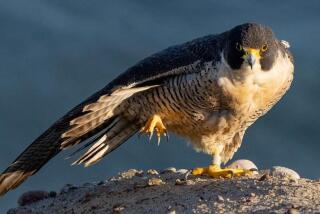Ready, Set, Soar
FILLMORE — Three California condors were released to the Ventura County back country Tuesday, where the species was driven from the wild and appeared headed for extinction 14 years ago.
Although the trio is but a small addition to the 57 other condors living wild across the West, their return to the Sespe wilderness marks an important milestone on the comeback trail for the endangered birds.
An adult female condor was removed from the Los Padres National Forest near Fillmore in 1986, the last of a handful of the giant birds that remained on the planet at that time. Known as adult condor 8, or AC-8, she had lived in zoos in San Diego and Los Angeles counties, where she had been a prolific egg-layer in the program to breed condors in captivity for eventual reintroduction to their native habitat. Scientists decided to set her free, because she stopped producing eggs five years ago.
She was released with two young condors in the hope that she can serve as a mentor to keep them out of trouble.
“This is a historic release,” said Marc Weitzel, project leader for the U.S. Fish and Wildlife Service office in Ventura. “It fulfills a long-term objective to put out some of these old birds to act as mentors. Condors function better in a social group.”
If their first taste of freedom is any indication, the birds appear to be off to a good start. About midmorning, AC-8 bounded from her box on a remote ridge top, flexed her 9-foot wingspan and launched into the air, circling a cliff and landing on a dead tree. Within moments, one of the younger birds hopped into the tree, though wings of the juvenile birds are not yet developed enough for soaring flight. They dined on a dead calf left on the mountainside by scientists.
With their return to Ventura County, condors are now based in three locations in California, including 15 in Big Sur and 19 in Santa Barbara County. Some birds also have been released in Arizona, near the Grand Canyon. About 95 birds remain in captivity as part of the breeding program, officials said.
The California condor is the biggest bird in North America. Thousands of them once soared over woolly mammoths and saber-toothed cats. They look like huge buzzards, but scientists say they are related to storks. They ride warm-air currents like conveyor belts over mountain ranges from San Luis Obispo to Frazier Park and across the Tehachapi Mountains to Tulare and the Sierra Nevada. Soaring at 55 mph, they can cover up to 300 miles in a day. They eat dead deer and livestock, and they once inhabited the entire continent.
After European settlers arrived, the bird’s numbers were decimated by egg thefts, poison, shooters and loss of game animals for forage. The last condor was taken from the wild in 1987.
In 1992, scientists tried to reintroduce them to the wild at the Sespe Condor Sanctuary, but that was terminated after five birds were killed by contact with power lines.
The birds are curious scavengers and have encountered a number of problems. They sometimes crash into power lines, sip antifreeze and are poisoned by lead shot in dead animals.
To give the three newly released birds a better chance of survival, the birds underwent power-line aversion training, in which the birds received a jolt whenever they lighted on an electrified wire in their cage at Los Angeles Zoo.
About $25 million has been spent on condor recovery efforts, including captive breeding, habitat acquisitions and surveillance. Biologists watch over the birds around the clock, supplying them with food, shooing them from trouble and tracking them with satellites and radio signals. The Fish and Wildlife Service aims to establish 500 wild condors in California, Arizona and New Mexico by 2020.
But some scientists have serious doubts about their long-term viability in Southern California, historically a condor stronghold. Human population growth, development, pollution and shooters pose a serious hazard to the birds. Some environmental groups once advocated letting the species go extinct rather than continue to live as wards in an intensive-care protection program.
“It has always been controversial,” said Ted Molter, spokesman for the Zoological Society of San Diego. “But being able to put one of these animals back into the wild is just such a huge step forward.”
More to Read
Sign up for The Wild
We’ll help you find the best places to hike, bike and run, as well as the perfect silent spots for meditation and yoga.
You may occasionally receive promotional content from the Los Angeles Times.






